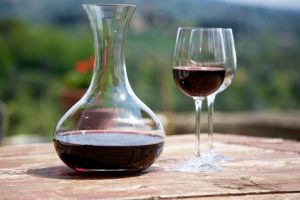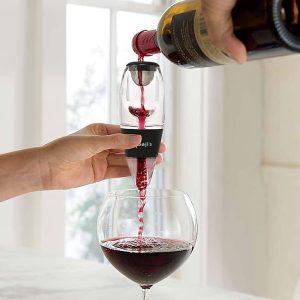Aerating wine is a process that involves allowing oxygen to enter the wine in order to enhance its taste and aroma. This can be done in various ways, such as pouring the wine into a decanter and letting it rest for a certain period of time, or using a wine aerator.
The aeration process can help release the aromas and flavors of the wine that may be trapped within the liquid. This can be particularly useful for young wines that need a little more time to develop their bouquet and flavor. Aeration can also help soften the tannins in red wine, making it easier to drink.
Aerating wine can have several benefits, including:
Release of aromas and flavors: Aeration can help release the aromas and flavors of the wine that may be trapped within the liquid. This can enhance the wine tasting experience and allow you to fully enjoy all the flavor notes it has to offer.
Softening of tannins: Aeration can also help soften the tannins in red wines, making the wine easier to drink and less astringent. Tannins are natural compounds present in grapes that give red wines their texture and body, but in excess, they can be unpleasant for some individuals.
Improvement of texture: Aeration can also improve the texture of the wine by making it smoother and silkier on the palate. This can enhance the overall wine tasting experience.
Acceleration of the maturation process: For young wines, aeration can accelerate the maturation process by oxygenating the wine, which can help release the aromas and flavors more quickly.
How to Aerate Your Wine?
- Aeration with a decanter:
Decanting your wine is a simple and effective technique for aerating it. Simply pour the wine into a decanter with a wide neck, as this allows for a large surface area where oxygen can pass through.

- Aeration in the glass:
You may have noticed that the end of your glass of wine tastes better than the beginning. The wine has aerated. If you feel that your wine is too closed off, you can accelerate this aeration by gently swirling the wine in your glass.

- Aeration with a wine aerator:
A wine aerator is an adjustable tool that allows you to instantly and perfectly aerate any wine. Indeed, an aerator remains the simplest tool to aerate wine.

Which Wines to Aerate?
Both red and white wines can benefit from aeration, but preferably when they are young. However, it is important to note that not all wines benefit from aeration. Some older wines may lose their delicate aromas and flavor when exposed to too much oxygen. Therefore, it is important to understand the type of wine you are drinking and how aeration can affect its taste.
The following grape varieties benefit from quick aeration or one-hour decanting:
- Syrah
- Merlot
- Cabernet Sauvignon
- Malbec
- Syrah
- Bordeaux

In summary, aerating wine can be helpful in releasing aromas and flavors, as well as softening the tannins in red wines. However, it is important to understand the type of wine you are drinking and how aeration can affect its taste before deciding whether to aerate it or not.
Should Natural Wines be Aerated?
Aerating a natural wine can help release the natural aromas and flavors that may be trapped within the liquid. Natural wines are produced using artisanal methods, without the use of chemicals such as sulfites. This means they are often more complex and have a greater variety of aromas and flavors than conventional wines.
However, it is important to note that not all natural wines benefit from aeration. Some older natural wines may lose their delicate aromas and flavor when exposed to too much oxygen. Therefore, it is important to understand the type of natural wine you are drinking and how aeration can affect its taste.
Discover our range of Milite Pour la Nature natural wines available on our online store!

In this new range, you will find:
A beautiful Syrah from the south of France. This natural wine allows the delicious grape variety to express itself with lovely notes of ripe red fruits, violet, and peony, with a hint of licorice on the finish.
We also have a fresh and delicate Sauvignon Blanc, a naturally made wine with tangy and fruity notes for a light and subtle wine. A pleasant moment to share during a good dinner or a get-together with friends.
And finally, a fresh Chardonnay, close to the grape variety and terroir of southern France, where delicate aromas of citrus and dried fruits fully come to life with a toasty finish. Perfect as an aperitif but also with aged cheeses.
Enjoy your tasting!
Cheers to the planet!
